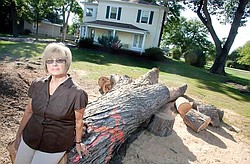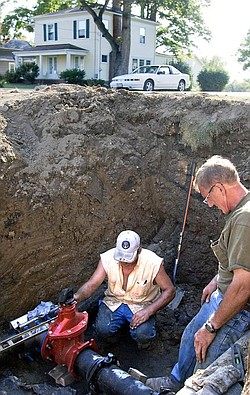Devil strip trees downed for waterline
HISTORIC TREES DOWN: Katie Bell of Cortland leans against one of the large trees in her front yard cut down by the city to make way for the construction of a new higher-capacity waterline. Most of the 10 large maple trees cut down were around 100 years old.
MEN AT WORK: Workers from J.S. Northeast Co., Girard, inspect an area where the new 12-inch waterline will replace the current 6-inch line along North High Street in Cortland.
Property owners along the route were nearly unanimous in favoring removal of the trees
By ED RUNYAN
VINDICATOR STAFF WRITER
CORTLAND — For those of us who grew up in the suburbs, the term “devil strip” is a bit of a curiosity.
In Northeast Ohio, the devil strip is the narrow strip of yard between a sidewalk and street.
Some say it is called that because few people know who has responsibility for it — the property owner or the government. Who the devil knows?
Another term is tree lawn, which suggests that trees are supposed to be there.
And yet, the Ohio Consumer’s Counsel, Ohio’s utilities watchdog, says all but the smallest types of tree and shrub don’t belong any closer than 15 feet from overhead power lines, which are generally strung above the devil strip.
What of neighborhoods — mostly found near the downtown of older cities — that do have them?
Trees in the devil strip are not among the favorite topics of Donald Wittman, service director for the city of Cortland, which has an older section from Main Street north to the city limits that has many sidewalks.
Asked recently about 10 maple trees, most of them apparently around 100 years old, that until recently lived in the devil strip on the west side of High Street, Wittman shrugged.
Asked whether removal of the trees during the construction of a new waterline had created any controversy, Wittman said: “No. Not until your article comes out.”
Wittman explained that the city took out the 10 trees from the police/administration building south to downtown over the last two weeks while replacing a 6-inch waterline with a 12-inch line.
The new line will provide the downtown with four times more water from the well fields behind the police/administration building than before. That will help with firefighting and increase water pressure. The 3,000-foot project will cost $365,000. The city will pay for it with a zero percent state loan.
Wittman said property owners along the route were nearly unanimous in favoring removal of the trees.
For one thing, some of the trees had rotted and were becoming a danger to the houses. One tree was nearly 4 feet in diameter.
For another, they were close to the sidewalk and had damaged it.
Third, the new waterline was installed directly below the sidewalk, Wittman said, meaning that excavation would have done a great deal of damage to the trees’ root system.
Fourth, trees that size are expensive to cut down. A commercial tree service will charge $2,000 to $3,000, Wittman said. But because of the waterline project, there is no cost to the homeowner.
Katie Bell, who has lived in her High Street home for about 30 years and who had a 100-year-old maple in the devil strip, agrees with Wittman.
“A lot of people asked me, ‘Are you upset?’ But it was so big. It’s roots were causing problems for the sidewalk. Branches and limbs fall on the road. For me, I’m glad the project came about, so it could solve a lot of things,” she said.
Bell, who has a similar maple tree growing within feet of the back of her house, said trees like that leave a person with an uneasy feeling, especially during a storm.
Michael Hillman, a part-time Cortland firefighter, former Cort-land Council member and vice president of the Bowers Insurance Agency on High Street, said he didn’t mind that one of the maples came down from in front of the insurance business.
Hillman said it’s sad to see the trees go, but safety is more important. Some of the trees were an obstacle to drivers pulling from the side streets off of High Street.
“I’d rather have water pressure for a firefighter than a tree,” Hillman said.
One of the workers from J.S. Northeast of Girard working on the waterline this week said he’d encountered no complaints from anyone while removing the trees.
Paul Kostyu, spokesman for the Ohio Consumer’s Counsel based in Columbus, said there are limits to what types of trees can be planted in the area he has always called the “boulevard.” Anything with deep roots can interfere with underground utilities or sidewalks, and anything that grows too tall may interfere with overhead wires, he said.
Because the devil strip is considered public land in most communities, utility companies have a right to trim or remove any trees that interfere with transmission lines, Kostyu said.
Alan Siewert, an urban forester with the Middlefield office of the Ohio Department of Natural Resources, said the devil strip served a different purpose 100 years ago when the Cortland maples were most likely planted.
Automobiles became common after the introduction of the Ford Model T in 1908. Before that, people drove wagons pulled by a team of horses. Trees lined the streets to keep the horses cool as they traveled. Trees also helped travelers know where the road was during snowstorms and kept automobiles cool before air conditioning, Siewert noted. The first power lines in America were strung just before 1900.
In many New England-style towns, the devil strip was an extension of the green space usually provided in the central square of the town. The devil strips radiated out from the center of the town. “We’ve had a long history of shade trees lining the streets,” Siewert said.
To Kathy Miller, 68, who has lived on High Street since 1969, seeing the trees come down last week was sad but understandable. She lives just north of where the trees came down.
“Those big trees have a history behind them. If they could talk, we could probably learn a lot. It’s sad to see them come down, but that’s progress.”
runyan@vindy.com
 43
43


